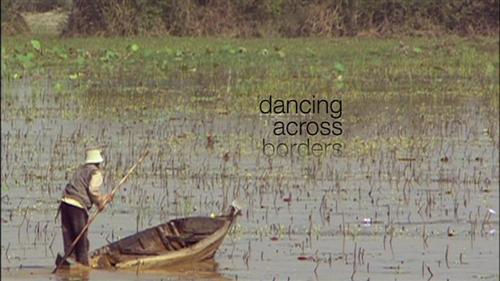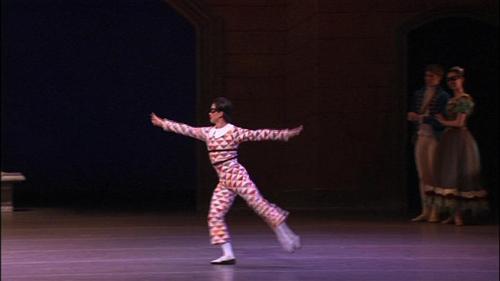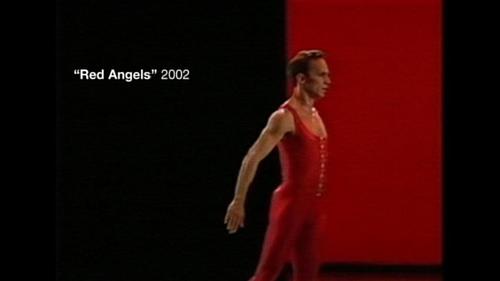
BUY FROM AMAZON: CLICK HERE!
STUDIO: First Look
MSRP: $27.95
RATED: Not Rated
RUNNING TIME: 88 Minutes
SPECIAL FEATURES:
- Clips of Sy performing
- Interview with director Ann Bass
- Photo Gallery
The Pitch
Isn’t great when rich Americans help poor people? Also, about four seconds of dancing.
The Humans
Sokvannara Sar, Olga Kostritzky, Anne Bass
The Nutshell
Sokvannara ‘Sy’ Sar danced with a small group of street performers in his home country of Cambodia until he was discovered by Ann Bass, who is (according to the back of the case) a patron of dance in America. Bass took him to America where he could become a real boy and now she wants you to know about, maybe talk about it in the salons even. Oh, and even though you’d barely know it from the film, Sy happens to be a fantastic ballet dancer.
The Lowdown
Dance is an act made for the cinema, like sex and violence. But, Dancing Across Borders isn’t about dance, but rather about how rich white women make life better for people in third world countries. Even though it’s peppered with training footage, the film is not concerned with Sy’s evolution as a dancer. Instead, it’s showing us the training footage as an extended montage. An advertisement for American assimilation and hard work. Sy was brought here and he worked hard to be an American, his talent was simply a bus ticket. Ann Bass, the director of the film, was Sy’s guardian socialite and the taint of someone putting on a show comes off the film strong. Sy is the one who should be showing off, he is an exceptional dancer when we are actually given the brief moment to focus on, but Bass is constantly in the background smugly watching over her project and basking in her own glory. Her posture is perfect and her eyes show less pride than elation from a way out of white guilt. She is stealing scenes in her own movie, and she’s doing it so we know she’s the one who brought Sy over from Cambodia. Hard to have a more shallow role in your own movie.

All you need is a pair of the world’s ugliest pajamas and a creepy mask to fly
Imagine you save a small child from drowning. You’d feel good about it, and you should, but it’s also something that anyone should have done. Now say you spend the next three years making a documentary about the child and his life after he drowned. You interview teachers where they tell you the child is good at math, because he isn’t dead. You interview his parents who tell you he likes to draw pictures of dinosaurs, and he couldn’t do that if he was dead. You do these interviews wearing a white top hat and twirling a cane (because that’s the equivalent of the smug air Bass puts out all the time) and standing next to the child the whole time. The final interview is with you, where you talk in a fake British accent and say how proud you are that the kid isn’t dead and then credits roll over a slow montage of you hugging people of different ethnicities. If you screened that movie for an audience, they would beat you senseless and feel like better people for doing it. What Ann Bass has done here is given the world a slightly disguised masturbation session and called it a film. Sy isn’t celebrated, he is a story to tell and the underlining fact that Ann Bass brought him to America is always present. The kudos should go to Sy and his raw talent, that is a story worth telling. The fact that he was trained classically in ballet because of Ann Bass bringing him to America, that’s just a series of events that lead to how Sy will eventually express his art.
The idea that Sy could be a talented artist outside of America, that he could have been anything more than a farmer without the help of all these talented East Coasters, seems offensive to anyone interviewed. What’s actually offensive is how quickly they brush over the natural abilities Sy has and attribute it all to training. If Sy wasn’t trained his seemingly cognitive ability to express himself through movement would not have withered and squandered, they simply would have been used in a different way. They do make a big deal out of how old he was when he started his training in America, but they make such a huge deal and focus on how hard it was to learn for him that it’s easy to forget he was four years older than these kids and is now fifty times more talented. They are sly about it though, this is ostensibly about Sy and how much he has achieved, so no one outright takes credit for his growth as an artist. Instead, the discussion just floats above the idea. Over and over again we hear about how he was taken from his hellish homeland and brought here, to the mecca of art that is America, and how he was trained by the best over here and now he can dance for us. Why, without America he’d still be dancing in the streets of his homeland. Using the sacred traditions and techniques that were taught to him and have been practiced for generations. How awful that would be, you can’t even find a decent car service in Cambodia.

What they calling ‘walking’, we call ‘getting crunk’
None of this amazingly offensive ode to America assimilation would mean a thing if Sy gave the slightest nod that this was the practice he would have chosen for himself. Sure, he appears grateful when asked, but the footage shows someone completely lost and forced down a path. When watching video of some of his earliest training sessions (with his living cliche of a Russian ballet instructor and, of course, the ever present Ann Bass) Sy appears on the edge of tears. It’d be easy to mistake the tears for tears of joy, that’s clearly what the director was shooting for, but moments after he asks his instructor why she was so hard on him. As a disturbing result, the instructor almost barks something to him and he quiets down. In fact, Sy stays quiet for most of the film. When he does talk, he mostly talks about being lonely and feeling out of place. The only time he seems happy off stage is when he returns to Cambodia, he looks around with a nostalgic gleam and points out all the places he missed. Of course, the director is in all of these spots gloriously misinterpreting Sy’s emotions and speaking up only to voice how great it is that he left. Philanthropy is best practiced in a neon suit and with as many cameras pointing at you as possible after all.

“Excuse me, where do you buy gold flaked toilet paper in this country?”
As a film about dance, Dancing Across Borders is about as informative as a Riverdance infomercial. It doesn’t even serve as a sub-Hallmark inspirational story. The only real purpose of the film is to peak into the ego of an American socialite.This is some sick pet project, made just to show us a great deed has been done. There are other underlining troubles in the themes, but nothing is as glaringly smug as the director appearing next to her ‘charity’ in nearly every shot. I don’t think I’m guessing intent when I say that director thought someone would see her and think about all the amazing things she has down for that poor third world child. Everyone interviewed wants to be noticed, wants to take some credit for what Sy has done. And poor Sy is openly sad and lost, open enough so the average viewer could feel it, and no one seems to notice. It’s disturbing at its core, it’s made worse by being presented as his story. Dancing Across Borders could be seen as a essay on a certain sect of the American psyche or a rally against the aging upper class, but it is not Sokvannara Sar’s story. He’s only a poorly used macguffin.

Protip: his weak point is the penis
The Package
The only extra of note is some clips of Sy performing. Thank the Gods they included it, because from the clips shown in the film you would have no way of gauging just how good he is. It’s a pleasure to actually see Sy happy and performing, and it shows that a better film could have been made with just his performances. Other than that, Ann Bass shows up for an interview that makes me angry just thinking about it. Video and audio are as expected with the varying quality and age of the footage in the film.
Rating: 




Out of a Possible 5 Stars